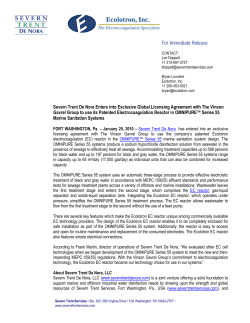
Risk-informed Design Optimization for the China
Risk-informed Design Optimization for the China LEAd-based Research Reactor Presented by Jin Wang Contributed by FDS Team Key Laboratory of Neutronics and Radiation Safety Institute of Nuclear Energy Safety Technology (INEST) Chinese Academy of Sciences www.fds.org.cn ————————————————— NURIS · Vienna ·April 2015 Contents China LEAd-based Research Reactor Risk-informed Design Optimization Conclusion NPPs in China Total 14 operating NPPs in Chinese mainland, about 27 NPPs under construction. Development of nuclear energy influenced by Fukushima Daiichi Accident but maybe not stopped. 14 operating NPPs include various reactor types, for example, PWR, PHWR, VVER, etc. Strategy and Research Government has set up the developing strategy PWR (Pressurized Water Reactor) → FBR (Fast Breeder Reactor) → FR (Fusion Reactor) Advanced hybrid nuclear energy system are now studied, including Fusion Driven Sub-critical System and Accelerator Driven Sub-critical System. ADS Program Since 2011 in China CAS has launched the ADS Engineering Project in 2011, and plan to construct the demo ADS transmutation system ~ 2030s through 3 stages. China LEAd-based Reactor (CLEAR) is selected as the reference reactor for ADS project and for Lead cooled Fast Reactor (LFR) technology development. ~2020s ADS Experimental Facility Reactor:China Lead-based Experimental Reactor CLEAR-II (~100MW) ~2010s ADS Research Facility Reactor:China Lead-based Research Reactor CLEAR-I (~10MW) ~2030s ADS Demonstration Facility Reactor:China Lead-based Demonstration Reactor CLEAR-III (~1000MW) RFQ Accelerate element High current ion source Superconducting cavity CLEAR-I Main Design Parameters Parameter Thermal power (MW) Core Cooling System Material Activity height (m) Fuel (enrichment) Primary coolant Inlet/Outlet temperature (℃) Coolant driven type Heat exchanger Primary pump Cladding Structure Values 10 0.8 UO2(19.75%) LBE 300/385 Forced circulation 4 2 15-15Ti 316L Overall View of CLEAR-I Structure Reactor vessel air cooling system Refueling and control rod driven system Vessel Structure support Cover Core Core shroud Safety Characteristics and Requirements Inherent Safety Lead-based coolant safety advantages: Chemical inertial, low operation pressure, high boiling temperature, etc. Large thermal inertia: Large coolant inventory to power ratio (~700t / 10MW) Passive safety: Passive decay heat removal by Reactor Vessel Air Cooling System (RVACS) Negative reactivity feedback Safety Goals Core Damage Frequency: 1.0E-6/ry for internal events Radioactive Material Release Limit: Whole body dose < 0.25 Sv for 2 hours at Exclusion Area Boundary (EAB). Contents China LEAd-based Research Reactor Risk-informed Design Optimization Conclusion PSA in China PSA is mandatory by Chinese regulatory authority, National Nuclear Safety Administration, during the application procedure for a license. Now all the operating NPPs have finished their level-1 PSA (full power mode and internal hazards included). Level-1shutdown and low power, Level-2 and seismic PSA are undergoing. Some applications of PSA have also been carried out by NPPs, for example, Risk Monitors, RCM (Reliability Centered Maintenance), optimization of Technical Specification. Risk-informed Regulation Meet with the requirements of nuclear regulation authority Ensure defense in depth Improve plant performance Risk Informed Regulation Maintain safety margin Keep incremental risk under safety goal RIR combines PSA and DSA methodologies together. Initiating Events (IE) Selection Methods Master Logic Diagram (MLD) Initiating events list of other lead-based reactors Engineering evaluation, e.g. FMECA Operation experiences Label IE-T Name General Transient Frequency (/ry) 1.10E+00 IE-L1 Loss of Coolant in Primary Cooling System 3.35E-04 IE-MHTR Tube Rupture of Main Heat Exchanger 1.00E-03 IE-L2 Loss of Coolant in Secondary Cooling System 1.00E-02 IE-ST Transient in Secondary Loop 5.26E-02 IE-LOOP Loss of Offsite Power 4.60E-02 IE-CF Cooling Fault of Core Assembly 4.00E-08 Event Trees and Fault Trees Analysis Method Standard small event tree/ large fault tree Fault Tree Analysis Scope Reactor Shutdown System Primary and Secondary Cooling System Reactor Vessel Air Cooling System Other Safety Related Systems Summary of Fault Tree Size Reactor Shutdown System: ~500 gates and basic events Secondary Cooling System: ~150 gates and basic events RVACS: ~200 gates and basic events Reliability Data of CLEAR-I General Data Sources IAEA-TECDOC-478 NUREG/CR-6928 Other fast reactors Engineering judgment Specific Data Collection Experimental facilities Equipment reliability test Bayesian analysis Reliability and Probabilistic Safety Assessment Program (RiskA) Risk Monitor for Nuclear Power Plant (RiskAngel/TQRM) Qinshan nuclear power plant Risk Monitor First safety analysis software applied in nuclear power plants with fully intellectual property right in China Summary of Preliminary Quantification Analysis Reliability of Accident Mitigation System Probability of shutdown system failure: 1.4E-10 Secondary cooling system failure: 1.2E-04 RVACS failure including passive function fault: 6.0E-05 Distribution of Core Damage Frequency (CDF) for IE CDF for internal events: 2.08E-07/ry Technical Insights The risk of operation of CLEAR-I is very low, it satisfy the safety target: the order of 10E-06/ry. General transient play important role in core damage. CDF of general transient: 7.39E-08/ry (35.5%) Simultaneity failure of normal heat transfer system and RVACS contribute most CDF ratio. The failure of passive function of RVACS plays very important role in overall risk reduction worth. CDF will increase 60 times if passive function fault occurred in one of the four alignments of RVACS. Risk-informed Design Cases One important application of PSA in CLEAR-I design is the identification of some situation that could increase the core damage risk or system unavailability, and providing correction or optimization actions. Two alternative conceptual design of CLEAR-I for risk reduction purpose have been evaluated by PSA. If the heat removal function of pressurizer in secondary cooling was taken into account in Emergency Operation Procedure (EOP). It will reduce 18% of total CDF. If another safety class pump was installed in secondary circulation, it will reduce 10% of total CDF. Contents China LEAd-based Research Reactor Risk-informed Design Optimization Conclusion Conclusion Conceptual design of CLEAR-I has been finished, it has inherent safety characteristics and rigorous safety goals. Preliminary PSA was performed, standard small event tree/ large fault tree method was used in PSA model development. Quantitative analysis was performed using RiskA software, and the result indicates that the overall risk of CLEAR-I is considerably low. Risk-informed design method has been applied in design process of CLEAR-I since the beginning of conceptual design. Website: www.fds.org.cn E-mail: contact@fds.org.cn
© Copyright 2025












